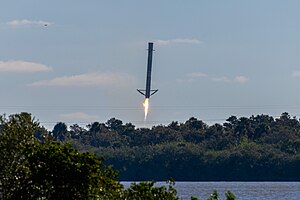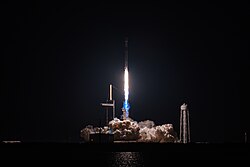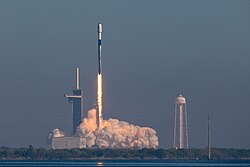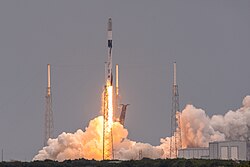| Falcon 9 booster B1060 | |
|---|---|
 B1060 on ASOG arriving into Port Canaveral after its 10th flight that sent some Starlink satellites to space B1060 on ASOG arriving into Port Canaveral after its 10th flight that sent some Starlink satellites to space | |
| General information | |
| Type | Falcon 9 first stage booster |
| National origin | United States |
| Manufacturer | SpaceX |
| Status | Retired; Expended |
| Construction number | B1060 |
| Flights | 20 |
| History | |
| First flight | 30 June 2020 (USA-304 Matthew Henson) |
| Last flight | 28 April 2024 (Galileo FOC FM25 & FM27) |
Falcon 9 B1060 was a Falcon 9 first-stage booster manufactured and operated by SpaceX. It was the senior active booster vehicle for the company since the demise of B1058 on 25 December 2023 during transit back to shore, until being expended for the Galileo FOC FM25 & FM27 mission on 28 April 2024. It had flown 20 missions and landed 19 times.
First flying in the summer of 2020, B1060 had broken several records in spaceflight, and launched the first successful American Lunar lander since 1972.
Activities
First flight
On its maiden flight, B1060 launched GPS III SV03 into a middle Earth orbit with an inclination of 55 degrees from SLC-40. SpaceX was awarded five GPS III launches, with the then-Air Force awarding the company the satellite family's maiden launch in 2017. That mission was flown successfully on 23 December 2018, and required a newly built Falcon 9 Block 5 (B1054) to be expended on its maiden flight. This launch, the Space Force had approved for the rocket to withhold some of its propellant, allowing B1060 to land on droneship Just Read The Instructions after completing its mission.
Starlink duty and records
Due to landing failures of previous flight-proven boosters, the early success of B1060 was seen as key to expand SpaceX's Starlink service as quickly as possible.
For its second flight, B1060 was assigned to Starlink 11. This was slated to be the company's 100th launch, but that title eventually went to SAOCOM 1B. B1060 lofted 60 Starlink V1 satellites to low Earth orbit on 3 September 2020 and landed on Of Course I Still Love You. This was the first flight of this booster from LC-39A. B1060 flew its second Starlink mission, Starlink 14, on 24 October 2020, and landed on Just Read The Instructions. SpaceX was visibly working on its launch cadence, with the previous Starlink launch having taken place just four days prior. There were just 51 days between the second and third flight of this rocket, at the time an orbital flight turnaround world record. On its fifth flight, B1060 launched Starlink 18, just 28 hours before another Starlink mission, and broke a turnaround record again, this time launching twice in less than a month (27 days).
B1060 launched Starlink 22 on 24 March 2021, 15 years to the day after SpaceX's first orbital launch attempt (Falcon 1 flight 1). At the time, SpaceX planned for Starlink to have worldwide coverage later that year, while running a beta program. B1060 landed on Of Course I Still Love You after successfully completing its mission. The booster launched another 60 Starlink satellites to orbit for Starlink 24 on 29 April 2021, when SpaceX received permission to alter the trajectories of its Starlink satellites as the service stepped out of its beta phase.

B1060 launched six batches of Starlink V1.5 satellites, an upgrade announced in January 2021, between December 2021 and July 2023. During this period, SpaceX pushed the limits of its first-stage Falcon 9 boosters to launch, land and relaunch more frequently. By January 2022, B1060 was among four boosters with ten flights under its belt, marking the start of a longevity rivalry with Demo-2 booster B1058. After completing Group 4-19, B1060 became the first rocket booster to ever fly and land 13 times. It reached 15 at the beginning of 2023, requiring SpaceX to recertify its Falcon fleet for further duty in a process that lasted several months. In September that year, it reached 17 total flights with its first launch of Starlink V2 Mini satellites, from SLC-40. It launched its last batch of Starlink V2 Mini satellites from LC-39A on 24 March 2024, again on the anniversary of SpaceX's first orbital launch attempt.
Commercial satellite launches
The launch of Türksat 5A was the first orbital launch of 2021. It was preceded by a series of protests, owing to the tensions between Azerbaijan and Armenia, near SpaceX Headquarters. The launch was successful and B1060 landed on Just Read The Instructions. The rocket launched Galaxy 33 and 34 for Intelsat on 8 October 2022, and tied with B1058 for the most completed flights for first-stage rockets, at fourteen.

Transporter missions
Transporter, SpaceX's satellite ridesharing service, was established in 2019 to serve relatively affordable access to space for smaller businesses, universities and individuals, in particular for those operating large amounts of small satellites.
B1060 flew Transporter-2 on 30 June 2021, the anniversary of its first launch. It was the second mission to a polar orbit from Florida by SpaceX. A total of 88 payloads were released, including three Starlink satellites, several satellites for the Pentagon and the pathfinder for NASA's TROPICS mission. After stage separation, B1060 performed its first return-to-launch-site landing.
The booster opened a busy 2023 with the launch of its second ridesharing mission, Transporter-6, releasing 114 payloads into sun-synchronous orbit. SpaceX uploaded a sped-up onboard video of the booster's launch and landing on this mission.

Launch of IM-1
Main article: IM-1B1060 was assigned to IM-1, the second landing attempt for NASA's Commercial Lunar Payload Services program, in late January or early February 2024. It had not launched since September 2023.
The Nova-C lander, named Odysseus, was powered by liquid methane and oxygen, requiring it to be fueled on the launchpad while encapsulated in its payload fairing. Issues with this process delayed the launch with one day, but the mission launched within the tight window of opportunity, on 15 February 2024. This was the first time a Lunar mission lifted off from LC-39A since Apollo 17 in 1972, as well as the 300th Falcon 9 mission. The booster performed a successful return-to-launch-site landing at LZ-1, completing its eighteenth flight.
Odysseus would eventually touch down on Malapert A, becoming the first commercially developed vehicle to ever soft-land on the Moon, and the first successful American Lunar landing since the end of the Apollo program 52 years prior. NASA mentioned SpaceX as a key contributor to the success of this mission.
Galileo (final flight)
In the early 2020s, the European Space Agency was forced to move most launches of its fully European-produced satellites to SpaceX. The agency lost its own capability to launch heavier payloads after the retirement of the Ariane 5 in 2023, and tensions with Russia following its 2022 invasion of Ukraine put its use of Soyuz rockets on hold. While waiting for the Ariane 6 to become operational, the Falcon 9 became the agency's launch vehicle of choice. Among the payloads put forward are four satellites for Galileo, the European Union's independent satellite navigation system co-developed with ESA.
For its 20th and final flight, B1060 launched a pair of Galileo satellites, FM25 "Patrick" and FM27 "Julina", into medium-Earth orbit on 28 April 2024 UTC. ESA and the EU paid approximately €180 million ($192 million) to SpaceX to conduct two Galileo missions. Being the senior and one of the most often flown Falcon 9 first stages, the decision was made to use this booster for the flight, that required SpaceX to burn the rocket to depletion to meet the extra performance requirements needed for the mission.
Flight history
| Flight # | Launch date (UTC) | Payload | Mission # | Pictures | Launchpad | Landing location | Notes |
|---|---|---|---|---|---|---|---|
| 1 | 30 June 2020 | GPS III SV03 Matthew Henson | F9-088 | 
|
SLC-40 | Just Read the Instructions | Maiden flight of B1060 booster. |
| 2 | 3 September 2020 | Starlink × 60 (v1.0 L11) | F9-093 ♺ | LC-39A | Of Course I Still Love You | Starlink mission. | |
| 3 | 24 October 2020 | Starlink × 60 (v1.0 L14) | F9-096 ♺ | 
|
SLC-40 | Just Read the Instructions | Starlink mission and 100th successful launch of a Falcon vehicle. |
| 4 | 8 January 2021 | Türksat 5A | F9-104 ♺ | 
|
SLC-40 | Just Read the Instructions | This is the most powerful satellite in Türksat's fleet and will provide Ku-band television broadcast services over Turkey, the Middle East, Europe and Africa. The satellite was injected in to a Super-synchronous transfer orbit of 280 km × 55,000 km (170 mi × 34,180 mi) with 17.6° inclination. |
| 5 | 4 February 2021 | Starlink × 60 (v1.0 L18) | F9-107 ♺ | SLC-40 | Of Course I Still Love You | Starlink mission. This set a new booster turnaround record, at 27 days, and it was the first time a Falcon 9 flew twice within a month. | |
| 6 | 24 March 2021 | Starlink × 60 (v1.0 L22) | F9-112 ♺ | 
|
SLC-40 | Of Course I Still Love You | Starlink mission. |
| 7 | 29 April 2021 | Starlink × 60 (v1.0 L24) | F9-115 ♺ | 
|
SLC-40 | Just Read the Instructions | Starlink mission. |
| 8 | 30 June 2021 | Transporter-2 | F9-123 ♺ | 
|
SLC-40 | SpaceX Landing Zone 1 | Dedicated 88 satellite rideshare mission. |
| 9 | 2 December 2021 | Starlink × 48 (Group 4-3) | F9-130 ♺ | 
|
SLC-40 | A Shortfall of Gravitas | Starlink mission with two BlackSky Gen-2 satellites (numbered 12 and 13) as rideshare payloads. |
| 10 | 19 January 2022 | Starlink × 49 (Group 4-6) | F9-137 ♺ | 
|
LC-39A | A Shortfall of Gravitas | Starlink mission. |
| 11 | 3 March 2022 | Starlink × 47 (Group 4-9) | F9-143 ♺ | 
|
LC-39A | Just Read the Instructions | Starlink mission. |
| 12 | 21 April 2022 | Starlink × 53 (Group 4-14) | F9-149 ♺ | 
|
SLC-40 | Just Read the Instructions | Starlink mission. |
| 13 | 17 June 2022 | Starlink × 53 (Group 4-19) | F9-158 ♺ | 
|
LC-39A | A Shortfall of Gravitas | Starlink mission. This mission marked SpaceX's 100th reuse of a booster, 50th consecutive landing, 1st booster to fly for a 13th time, and 50th SpaceX launch from LC-39A. |
| 14 | 8 October 2022 | Galaxy 33 & 34 | F9-180 ♺ | 
|
SLC-40 | A Shortfall of Gravitas | Northrop Grumman-built satellites for C-band clearing. At 7,350 kg total mass, this launch was one of the heaviest GTO SpaceX launches to date. This necessitated that the satellite be launched into a lower-energy orbit than a usual GTO, with its initial apogee at roughly 19,800 km (12,300 mi). |
| 15 | 3 January 2023 | Transporter-6 | F9-195 ♺ | 
|
SLC-40 | SpaceX Landing Zone 1 | Dedicated 115 satellite rideshare mission. |
| 16 | 16 July 2023 | Starlink x 54 (Group 5-15) | F9-239 ♺ | SLC-40 | A Shortfall of Gravitas | Last v1.5 Starlink launch. Second booster flying for the 16th time. | |
| 17 | 24 September 2023 | Starlink v2 × 22 (Group 6-18) | F9-258 ♺ | SLC-40 | Just Read the Instructions | Starlink mission. | |
| 18 | 15 February 2024 | IM-1 (Nova-C) Odysseus lander | F9-299 ♺ | 
|
LC-39A | SpaceX Landing Zone 1 | Launched a lunar lander with several payloads that successfully landed on the moon. |
| 19 | 24 March 2024 | Starlink v2 × 23 (Group 6-42) | F9-313 ♺ | LC-39A | Just Read the Instructions | Starlink mission. | |
| 20 | 28 April 2024 | Galileo FOC FM25 & FM27 | F9-328 | LC-39A | No Attempt | Galileo FOC M12 Mission. |
Note
- Mission names are presented in parentheses when applicable.
- Entries with colored background and ♺ symbol denote flights using refurbished boosters from previous flights.
References
- Evans, Ben (13 February 2024). "Life-Leading Falcon 9 Readies for Tomorrow's IM-1 Lunar Launch - AmericaSpace". AmericaSpace.com. Archived from the original on 25 February 2024. Retrieved 20 February 2024.
- ^ "Falcon 9 Block 5 | Galileo FOC FM25 & FM27". nextspaceflight.com. Retrieved 2024-04-24.
- ^ Wall, Mike (24 March 2024). "SpaceX Falcon 9 rocket ties reuse record with 19th launch". Space.com. Archived from the original on 22 April 2024. Retrieved 24 March 2024.
- ^ Sharp, John (13 February 2024). "SpaceX launches Intuitive Machines IM-1 mission from Florida". NASASpaceFlight.com. Archived from the original on 4 April 2024. Retrieved 17 February 2024.
- ^ Atkinson, Ian (30 June 2020). "SpaceX launches third GPS Block III satellite". NASASpaceFlight.com. Archived from the original on 4 April 2023. Retrieved 20 February 2024.
- ^ Gray, Tyler (3 September 2020). "SpaceX launches latest Starlink mission". NASASpaceFlight.com. Archived from the original on 4 April 2023. Retrieved 20 February 2024.
- Ralph, Eric (22 October 2020). "SpaceX go for third Starlink in one month as rare six-flight booster returns to port". TESLARATI. Archived from the original on 20 February 2024. Retrieved 20 February 2024.
- Ralph, Eric (4 February 2021). "SpaceX Falcon 9 rocket cuts Space Shuttle turnaround record in half". TESLARATI. Archived from the original on 25 January 2024. Retrieved 20 February 2024.
- Sesnic, Trevor (14 March 2021). "Starlink 22 | Falcon 9 Block 5". Everyday Astronaut. Archived from the original on 20 February 2024. Retrieved 20 February 2024.
- Lentz, Danny (29 April 2021). "Starlink v1.0 L24 launches as SpaceX receives permission for Starlink modifications". NASASpaceFlight.com. Archived from the original on 2 June 2023. Retrieved 24 February 2024.
- Kurkowski, Seth (29 January 2021). "SpaceX preparing to upgrade Starlink satellites to 1.5 and 2.0 variants". Space Explored. Archived from the original on 23 March 2023. Retrieved 24 February 2024.
- Ralph, Eric (1 December 2021). "SpaceX confirms Starlink launch plans hours before Thursday liftoff". TESLARATI. Archived from the original on 1 March 2024. Retrieved 24 February 2024.
- ^ Wall, Mike (23 September 2023). "SpaceX rocket launches on record-tying 17th mission". Space.com. Archived from the original on 2 December 2023.
- Ralph, Eric (2022-01-17). "SpaceX readies 4th Falcon 9 booster for 10th launch and landing [webcast]". TESLARATI. Retrieved 2024-02-24.
- Neal, Mihir (17 June 2022). "SpaceX launches Starlink satellites on booster's 13th flight". NASASpaceFlight.com. Archived from the original on 8 April 2023. Retrieved 24 February 2024.
- Clark, Stephen (10 July 2023). "SpaceX is stretching the lifetime of its reusable Falcon 9 boosters". Ars Technica. Archived from the original on 13 January 2024. Retrieved 24 February 2024.
- Thompson, Amy (7 January 2021). "SpaceX will launch the Turksat 5A satellite for Turkey tonight. Here's how to watch live". Space.com. Archived from the original on 20 February 2024. Retrieved 20 February 2024.
- Wall, Mike (9 October 2022). "SpaceX Falcon 9 rocket launches 2 satellites on record-tying 14th mission". Space.com. Archived from the original on 24 February 2024. Retrieved 24 February 2024.
- Roulette, Joey (24 January 2021). "SpaceX launches record batch of satellites in first in-house rideshare mission". The Verge. Archived from the original on 24 February 2024. Retrieved 24 February 2024.
- SpaceX. "Transporter-2 Mission". SpaceX. Retrieved 2024-02-24.
- Foust, Jeff (2021-06-30). "SpaceX launches second dedicated rideshare mission". SpaceNews. Retrieved 2024-02-24.
- Mathewson, Samantha (3 July 2021). "SpaceX tracking camera captures epic video of Falcon 9 rocket landing". Space.com. Archived from the original on 24 February 2024. Retrieved 24 February 2024.
- Duffy, Ryan (2023-01-04). "SpaceX Launches Transporter-6 Mission with Stacked Manifest". Payload. Retrieved 2024-02-24.
- Fly to space and back in amazing SpaceX booster cam video - Launch to Florida landing, 5 January 2023, retrieved 2024-02-24
- Malik, Tariq (14 February 2024). "SpaceX delays launch of private Intuitive Machines moon lander due to methane fuel issue". Space.com. Archived from the original on 8 April 2024. Retrieved 25 February 2024.
- "Lunar lander launched, separated successfully in latest U.S. moon attempt". CBC News. Thomson Reuters. 15 February 2024. Archived from the original on 15 March 2024.
- Dooren, Jennifer M.; McKie, Faith; Fox, Karen; Ramji, Nilufar; Sorto, Laura, eds. (23 February 2024). "NASA Tech Contributes to Soft Moon Landing, Agency Science Underway - NASA" (Press release). NASA. 24-033. Archived from the original on 6 April 2024. Retrieved 24 February 2024.
- Clark, Stephen (2023-07-01). "Europe's Euclid telescope launched to study the dark Universe". Ars Technica. Retrieved 2024-04-24.
- "SpaceX Falcon 9 v1.2 Data Sheet / Falcon 9 v1.1 and v1.2 Flight History". 25 July 2018. Archived from the original on 20 September 2016. Retrieved 28 July 2018.
- "Spaceflight Now: Launch schedule". Retrieved 6 June 2020.
- "SpaceX launches second Starlink mission of the week". NASASpaceFlight.com. 30 January 2021. Archived from the original on 30 January 2021. Retrieved 25 February 2024.
- Krebs, Gunter. "Türksat 5A". Gunter's Space Page. Archived from the original on 8 December 2023. Retrieved 9 November 2017.
- Sesnic, Trevor (29 December 2020). "Türksat 5A | Falcon 9 Block 5". Everyday Astronaut. Archived from the original on 10 March 2021. Retrieved 8 January 2021.
- "First launch of 2021 sees SpaceX Falcon 9 place Turksat 5A into supersync GTO". 8 January 2021. Archived from the original on 9 June 2023. Retrieved 13 December 2023.
- "Starlink V1 L18". Retrieved 30 August 2021.
- "Next Space Flight- Launches". nextspaceflight.com.
- "Next Space Flight- Launches". nextspaceflight.com.
- "Next Space Flight- Launches". nextspaceflight.com.
- Clark, Stephen. "Live coverage: SpaceX launches Starlink and BlackSky satellites – Spaceflight Now". Retrieved 25 February 2024.
- "BlackSky 1, ..., 60". Archived from the original on 28 February 2023. Retrieved 3 December 2021.
- Clark, Stephen (19 January 2022). "SpaceX launches 2,000th Starlink satellite". Spaceflight Now. Archived from the original on 28 November 2023. Retrieved 25 February 2024.
- Neal, Mihir (3 March 2022). "SpaceX keeping up the pace with Starlink Group 4-9 launch". NASASpaceFlight.com. Archived from the original on 31 May 2023. Retrieved 25 February 2024.
- Alcantarilla, Alejandro (21 April 2022). "SpaceX launch cadence moves forward with 53 more Starlink satellites to orbit". NASASpaceFlight.com. Archived from the original on 28 February 2023. Retrieved 25 February 2024.
- "Falcon 9 Block 5 | Starlink Group 4-19". nextspaceflight.com. Retrieved 26 May 2022.
- "Starlink Group 4-19 | Falcon 9 Block 5". Everyday Astronaut. 10 June 2022. Retrieved 16 June 2022.
- "Falcon 9 Block 5 | Galaxy 33 & 34". nextspaceflight.com. Retrieved 30 September 2022.
- Kelso, T.S. (9 October 2022). "CelesTrak has GP data for 3 objects from the launch (2022-128) of GALAXY 33 & 34 on a Falcon 9 rocket from Cape Canaveral on Oct 8 at 2305 UTC" (Tweet). Archived from the original on 23 April 2024 – via Twitter.
- "transporter 6". SpaceX. Retrieved 25 February 2024.
- Sesnic, Trevor; Romera, Alejandro Alcantarilla (14 July 2023). "Launch Roundup: SpaceX finishes Starlink v1 flights - China launches methane powered ZQ-2". NASASpaceFlight.com. Archived from the original on 7 October 2023. Retrieved 25 February 2024.
- Botero, Antonia Jaramillo (15 February 2024). "Liftoff! Intuitive Machines Lander Carrying NASA Science Begins Journey to the Moon – Artemis". Artemis blog. NASA. Archived from the original on 15 February 2024. Retrieved 25 February 2024.